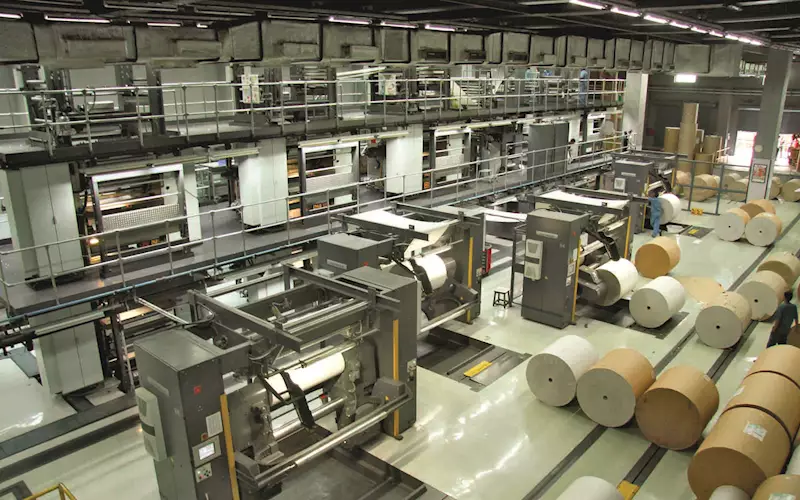Made for India, Manroland’s Cromoman is an ideal press for small and medium run newspapers and challenging space scenarios, reports Rushikesh S Aravkar after a visit to The Times of India Pune plant.
When the PrintWeek India team, visited Times of India’s Pune plant in August 2012, the company housed a newly installed Manroland Cromoman press, the first of its kind modular press world over. The installation was completed in a record time of 37 days, and the machine swung into action on 2 February, 2012.
“The product design of Cromoman was market driven,” says Eckhard Horner-Marass, managing director of Manroland during his maiden visit to India. He informs, “The design of the press was born out of ideas originating from customer requirements and feedback. They are so experienced with the engineering of presses that they could point out the most critical necessities they have been seeking in presses.”
Cromoman is a compact-sized, double-width (1,379 mm), single circumference (546 mm) press, which is built on the 2-1 concept. It combines the speed and productivity of a 4-1 double width press with the simple operation of a 2-1 single wide press, as the double wide web is slit into two single wide reels just after printing.
Natasha Tandon, global head of marketing and product management, Manroland Web Systems, based in Germany, says, “The Cromoman is the consequent further development of the proven 2-1 technology. It is a double-width, single-circumference press, four plates wide and thus featuring eight broadsheet pages per web with an output of up to 75,000 copies per hour.”
Savings
The USP of the press is its space saving height. Salai Vallan, assistant general manager at TOI Pune, says, “Cromoman, which is just 7.4m high, is shorter than its sister presses like Regioman or Colorman, we had to lower the plinth so as to accommodate the machine.”
According to Tandon, the height of the press can be further reduced to 5.4m for low ceiling pressrooms. This arrangement can be observed at The Times of India’s Kolkata plant, which houses the second Cromoman that was commissioned in September 2012.
The Cromoman features a great price-performance ratio, thanks to its fast installation time and the fact that no additional building costs are necessary, as the press adapts to almost every existing pressroom environment.
Salai Vallan adds, “The press requires low capital investment and due to its compactness, the operational costs, utility requirements and energy consumption also comes down.”
Additionally, air conditioning in the pressroom and expensive generators to ensure a continuous power supply with a constant voltage are no longer needed. Tandon explains, “In case of power outages or voltage fluctuations the press comes to a controlled standstill and thus avoids web breaks and production mess. It has special anti-wrap devices preventing web severance on power outages, reducing white and printed waste overall.”
The preinking feature of the press reduces paper and ink wastage significantly. The press also is compatible with locally available newsprint and consumables thus reducing overall running costs. Due to the optimum level of automation in the press in plate changing and webbing up, the press can also be run by a low number of operators thus reducing manpower costs. The flexible placement of the reel stands and turner bars allow easy access to the equipment and reduce the machine’s overall footprint.
The Cromoman is an ideal press for growing newspapers which wish to achieve more productivity by building on the 2-1 concept. “It is targeted at small and medium runs newspaper publishers across the globe. With Cromoman, the publishers can also expand their capacities and cater to contract printing by countering the frequent job changes on a tight schedule,” says Tandon.
The commendable feature of Cromoman is that the reel stands are positioned perpendicular to the press, which makes it possible to have the reel stand on the same floor. The press works with H-type printing units and can be equipped with quarter fold, dryer, and heatset equipment.
“This architecture has minimised the space requirements and reduced the length of paper travelling through the machine at a time. It also reduces the web-tension variations. This kind of feature will be the future at least for medium-scale print order requirements,” says Salai Vallan.
The press is designed as a highly flexible double width press that can be easily installed into existing pressrooms, owing to its low height and flexible placements of reel stands and turner bars.
The press is shaft-less; this makes it possible to perform maintenance works and routine clean-ups on the individual towers even when other towers are running. Tandon adds, “As you can tell from the speed, the Cromoman features enormous productivity, especially when it is configured as a coldset-heatset press printing around the clock, newspapers in the night, heatset products during the day. The fast plate changing time and pre-inking features significantly reduces makeready time thus increasing the productivity of the press.”
Salai Vallan says, “At night, we print several lakh copies of four editions: The Times of India, Maharashtra Times, The Economic Times and Pune Mirror.”
When enquired about the alternatives of Cromoman, Tandon says, “There are really no comparable products to the Cromoman. The flexibility and reliability of the press positions it in another class of flexible pressroom equipment, designed for high capacity and quality newspaper production.”
Summing up the facts, Tandon says, “What makes the Cromoman unique is the reliable and economical production of premium printing quality in an existing, sometimes challenging space and climate environment. The press can be installed in a very short time frame, thus ensuring faster time to market with new installations for the newspapers.”
|
Specifications |
|
Max web width 1,600mm |
|
Max speed 75,000cph |
|
Contact Natasha Tandon
Natasha.tandon@manroland-web.com
www.manroland-web.com
|














 See All
See All